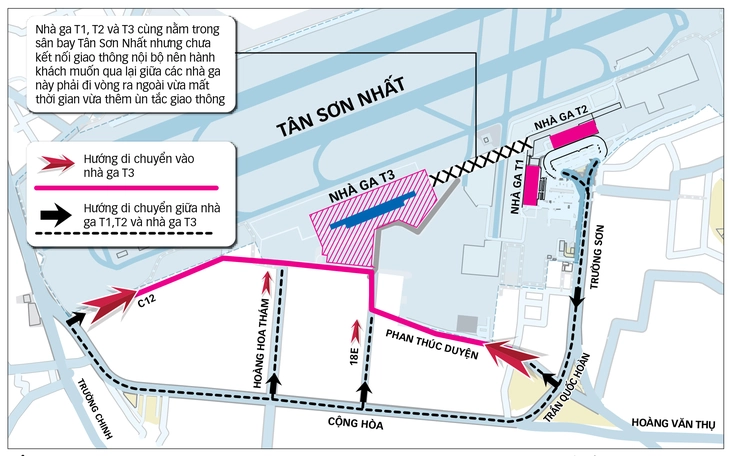
Organizing internal traffic connections in Tan Son Nhat airport will promote the effectiveness of terminal T3 - Graphics: TUAN ANH
The lack of internal connectivity makes the experience at the country's largest airport inconvenient.
Terminal T1 - T3 is so close but so far away
As one of the passengers who experienced the new terminal, Mr. N.D.D. (Binh Thanh, Ho Chi Minh City) said that he took a flight from Hanoi to Ho Chi Minh City and landed at terminal T3.
However, his personal car was parked at terminal T1 because when he flew to Hanoi on April 18, he checked in at terminal T1.
"The return flight was transferred to Terminal T3, but there was no way to walk to Terminal T1. I had to take a shuttle bus, which had to go around Truong Son Street, and got stuck in traffic for more than half an hour before arriving," Mr. D. recounted.
On many travel groups and social networks, many passengers share their confusion when having to move between stations.
"I thought it would only take a few minutes to get from T3 to T1, but I didn't expect to have to go outside, catch a bus, get stuck in traffic, and not see any clear directions," said Ms. Lan Anh, a passenger from Van Don to Ho Chi Minh City.
Although the three terminals at Tan Son Nhat airport, including T1 (domestic), T2 (international) and T3 (domestic), are located within the same airport campus, passengers cannot move directly between terminals T1 and T3 but must go around public roads such as Truong Son and Cong Hoa, which are often congested.
This not only affects individual passengers, but also causes inconvenience for those who need to connect between international and domestic flights. For flights with a transit point in Ho Chi Minh City, the lack of internal transfer options is a major minus point in the flight experience.
Although the need to travel between terminals is very frequent, there is still no direct internal connection, passengers are forced to use shuttle buses that go around the airport, through neighboring residential areas and then return to another terminal.
This is clearly a suboptimal solution, especially in the already congested traffic conditions around the airport.
Not only facing difficulties in internal connections, many people also reported inconveniences when accessing T3 terminal from the outside.
Tran Quoc Hoan - Cong Hoa route, although already open to traffic, has become the main axis leading to the new station, with three lanes in each direction and three direct connection points to the station.
However, according to actual records during rush hours, this route still experiences congestion, especially at major intersections.
Mr. Minh Tuan (living in District 10) shared his experience of going from District 3, seeing unclear signs, he made a wrong turn onto Hoang Van Thu Street, had to go back to Cong Hoa to reach T3 station. If there had been detailed directions from afar, he said he would not have gotten lost.
There will be internal roads in the airport.
Speaking to Tuoi Tre, the leader of Tan Son Nhat International Airport said that the internal connection system has not yet been deployed because the T3 terminal has only been in operation for less than a week and the number of flights has not been fully allocated.
During the peak period of the April 30 holiday, the port will temporarily not implement internal routes to ensure security and safety. However, the port will later pilot internal transfers for passengers who need to connect international - domestic flights or vice versa.
Accordingly, international passengers arriving at Terminal T2 of Tan Son Nhat Airport, if connecting to Hanoi, Da Nang ... will be arranged for internal transportation to Terminal T3. However, not all passengers will be transferred like that, but there will be specific regulations.
Meanwhile, a representative of the Road Traffic Infrastructure Management Center (Department of Transport and Public Works) said that they have increased the number of traffic control forces, installed more signs, and continued to adjust traffic light phases to better match the actual traffic outside the airport.
Previously, to support traffic to T3 terminal, the city opened the road connecting Tran Quoc Hoan - Cong Hoa on April 19, with three approaches to the terminal via two ground points and an overpass.
The road is organized in two directions, three lanes in each direction, with clear traffic flow for each type of vehicle.
In addition, five main directions from areas such as Thu Duc City, District 7, Go Vap, Tay Ninh Province, Long An... have been specifically informed for people to access more conveniently.
However, the center's representative also admitted that people going the wrong way or not being familiar with the route was inevitable in the early days.
"We will continue to survey and evaluate the situation to have a flexible and suitable organization plan. In the immediate future, we will adjust signs and traffic lights if necessary to reduce congestion at hot spots," he said.
In addition, the center also continues to study flexible traffic organization on Cong Hoa Street to ensure traffic capacity in each direction during morning and afternoon rush hours; along with the plan to build a parallel road on Truong Chinh Street (from Pham Van Bach Street to C12 Street), creating a continuous traffic flow from Truong Chinh Street to C12 Street to T3 Terminal.
Bus route 109 (Saigon bus station - airport) has also been increased in frequency to 110 trips/day to serve passengers at terminal T3. It is noted that the non-subsidized route 72-1 from the airport to Vung Tau bus station has also been adjusted to approach the new terminal.
Bus routes 103 and 152 continue to serve the T1 and T2 terminals. However, the connection between the three terminals within the same airport campus is still considered inconvenient.
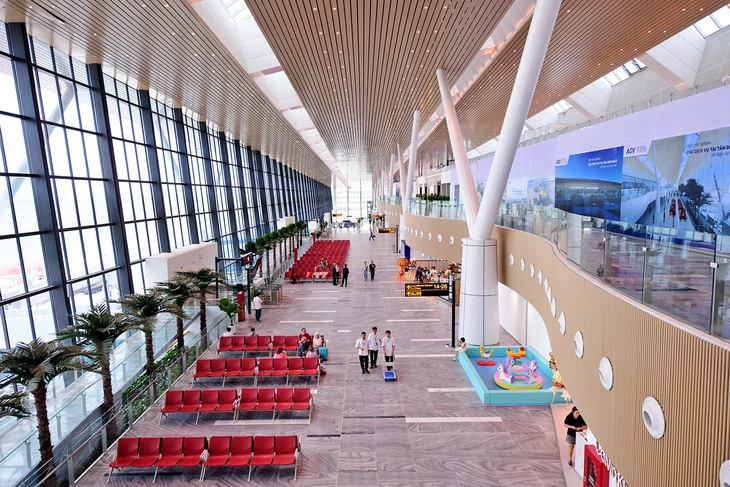
Terminal T3 of Tan Son Nhat Airport (HCMC) was inaugurated and put into use on the morning of April 19 - Photo: QUANG DINH
Outbound shuttle by electric bus
In order to support passengers in the initial phase of operation, Tan Son Nhat International Airport has deployed a completely free electric bus route (Vinbus) connecting between terminals.
Frequency is 15 - 20 minutes per trip, running from 4:30 am to 0:35 am the next morning, about 120 - 150 trips/day. The journey starts from T2 station, passes T1 (column B20), Truong Son - Hau Giang - Thang Long - Phan Thuc Duyen routes and ends at T3 station (column 19A), then turns around in the opposite direction.
However, this means of transportation still has to travel through public roads around the airport, so it is difficult to avoid traffic jams during rush hour, especially in the morning and late afternoon.
One of the major shortcomings is that the guidance for passengers to access the shuttle bus is not really effective. Many passengers still do not know where to pick up the bus or how to move between stations, leading to confusion and time loss.
Internal connection tunneling possible?
Some experts and residents have proposed building a tunnel or dedicated internal road to directly connect the stations. This way, passengers will not have to travel outside the residential area.
However, experts say that building a tunnel in an airport is a complex and expensive solution, and is difficult to implement under current conditions.
"Just looking at the Thu Thiem tunnel, where rescue drills must be regularly held, is enough to see the complexity of an underground project.
To build a tunnel, there must be space for the tunnel door, and currently, finding a few thousand square meters of empty land in an airport is not a simple matter," an infrastructure expert shared.
Lessons from Changi, Taoyuan
Experts say Vietnam can learn from the airport transportation organization model in Singapore and Taiwan, where passengers can easily move between terminals by mini-train (skytrain), internal bus or metro connecting to the outside.
At Changi Airport (Singapore), passengers can use the mini train to travel between terminals, then take the subway to the city. At Taoyuan Airport (Taiwan), the shuttle bus, skytrain and metro also operate in sync to help passengers not miss their flights.
Source: https://tuoitre.vn/san-bay-tan-son-nhat-nha-ga-t1-va-t3-bao-gio-moi-that-gan-20250422075404596.htm







![[Photo] Prime Minister Pham Minh Chinh and Prime Minister of the Kingdom of Thailand Paetongtarn Shinawatra attend the Vietnam-Thailand Business Forum 2025](https://vphoto.vietnam.vn/thumb/1200x675/vietnam/resource/IMAGE/2025/5/16/1cdfce54d25c48a68ae6fb9204f2171a)
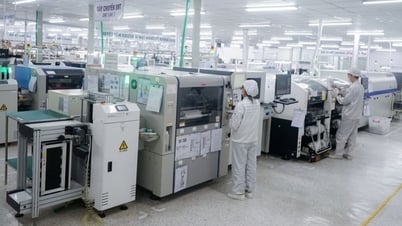







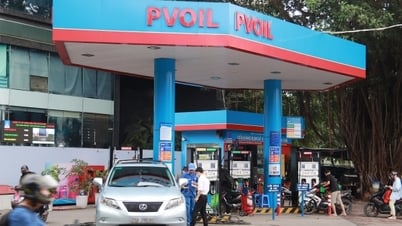








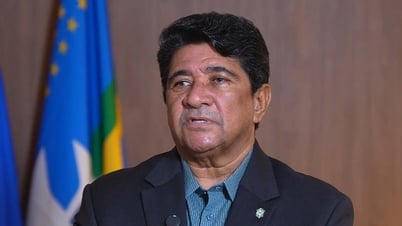

![[Photo] President Luong Cuong receives Prime Minister of the Kingdom of Thailand Paetongtarn Shinawatra](https://vphoto.vietnam.vn/thumb/1200x675/vietnam/resource/IMAGE/2025/5/16/52c73b27198a4e12bd6a903d1c218846)












































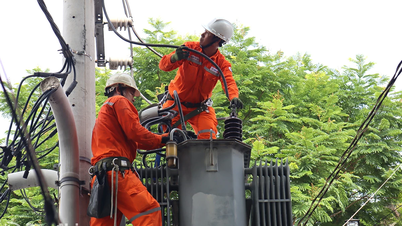



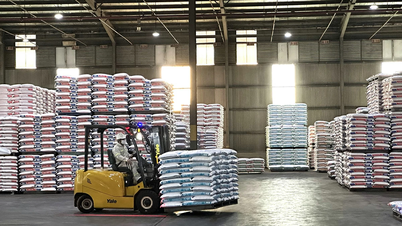















Comment (0)